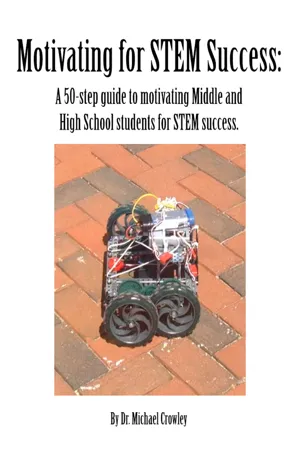Motivating for STEM Success:
A 50-step guide to motivating Middle and High School students for STEM success.
By Dr. Michael Crowley
In 50 thoughtful steps, Dr. Crowley, a practicing high school teacher of Engineering and Robotics in Massachusetts guides you through the process of creating a learning environment that will motivate your Middle and High School STEM students to master rigorous and long-duration STEM projects.
In the Principle in Practice areas of this first-in-a-series guide, he lays out clear examples of how he applies each of the 50 steps/principles in his classroom. Dr. Crowley’s ability to excite students about Engineering and Robotics has been recognized by many organizations over the years, and most recently in 2015, when he was named an Excite Award recipient from the Lemelson Foundation-MIT School of Engineering. A group of his students was also selected as one of 14 National Winners of the Lemelson-MIT InvenTeams invention initiative in 2015.
Here is a list of the topics covered in this guide:
Setting the stage for learning.
Pedagogy that works when teaching STEM.
A Reverse Engineering approach for program, course, unit, and lesson development.
A multi-disciplinary approach to your curriculum.
How to teach Engineering well.
Growing your program with the community as your partner.
Blue Ribbon engineering and robotics projects.
About the Author
Dr. Michael Crowley, a practicing high school teacher of Engineering and Robotics in Massachusetts, received his Doctor of Education degree, with a specialization in Computing and Information Technology in 1999. He has been recognized for his ability to motivate students to STEM success by prestigious organizations such as the Lemelson Foundation-MIT School of Engineering, the Freemasons Orient Lodge, and the Norfolk County Teachers Association in Massachusetts. He was also a finalist for the Laura Warcup Distinguished Educator Award in Norfolk County, Massachusetts in 2012. His inspiring teaching methods and dedication to student success have been recognized at the high school level with the Teacher of the Year award as well as the Caring Heart Award, bestowed by his high school’s parent-teacher organization.
Dr. Crowley began his teaching career in 1990 at the Franklin Institute of Technology, an engineering and technology college in Boston. Over his 25-year career teaching STEM, he has helped thousands discover where their true interests lie. His former students have gone on to graduate from some of the most prestigious institutes of technology and engineering colleges in America. His 50-step system for motivating students has drawn the praise of college presidents and high school principals.
Introduction
As a career STEM (Science, Technology, Engineering and Math) educator, I love teaching and I love learning. One of the things I have learned over the years, and what inspired me to write this book, is that very little has been written about the systems that motivate students in the area of STEM. STEM may receive plenty of media coverage, but very little organized information exists to help practitioners, particularly in Grades K-12. This is a 50-step “how-to” guide for practitioners!
This guide focuses on the techniques I have used over my 25-year teaching career to inspire students and motivate them to complete rigorous, long-duration projects in the areas of Engineering and Robotics. I am currently a practicing high school teacher of Engineering and Robotics in Massachusetts.
In the areas of this book labeled Principle in Practice, I explain how I put each principle to work in my classroom.
I hope this guide finds its way into the hands of new STEM teachers to help them in their early years, while also serving as a valuable resource for veteran STEM educators.
I welcome your feedback on any and all parts of this guide.
Dr. Crowley
Chapter 1 – Setting the stage for learning.
Step #1–Developing a “Culture of Inquiry.”
Successful STEM programs have created a Culture of Inquiry in both the instructor-led portion of the class and the laboratory portion. Inquiry refers to the ability of the student to listen to the challenge or problem that is presented by the instructor and then come up with the key questions that will lead to the solution to the problem. Inquiry should not be taught as a separate topic. Rather, it should be developed as a habit of mind. When I was a child, I would find myself looking at mechanical devices and envisioning what types of gears were inside that created movement. This interest in gathering information to explain an outcome is what I refer to as Inquiry.
It is important to note, however, that this emphasis on inquiry must be cultivated in the early grades. By high school, students should be independently practicing inquiry.
Principle in Practice
An example of inquiry in action is when my high school students identify the key questions they need to answer in order to be successful in the Annual Technology Olympics. The Technology Olympics event is the Capstone project for our year-long Engineering-1 course. When describing this event, I tell the students they have to build a Mars Pathfinder rover-style vehicle that will travel through a one-mile outdoor course, while maintaining continuous forward progress. The vehicle cannot be touched by students at any time as it travels through the course. If the students touch the rover, they are disqualified from the event. The rover vehicle that maintains continuous forward progress, and completes the course while using the least amount of power, wins the event.
The students need to use their powers of Inquiry to identify the key questions they need to answer in order to be successful in that Capstone event. Some of the key questions I expect the students to identify as part of their inquiry would be:
- How does the overall weight of the vehicle affect the amount of current it will draw?
- Should I focus on using a gear ratio that will produce speed or torque?
- In terms of wheel design, should my emphasis be on covering as much distance as possible for each full wheel rotation, or should I use a mountain tire tread design that will get my rover out of trouble in case it encounters any objects while out on the course?
If students come up with these questions during the Inquiry phase of rover development, they will be successful in this event. They will have identified, through Inquiry, the key areas on which to focus.
Step #2—Employ the “All Colleagues” Approach
The All Colleagues Approach is something the instructor should talk about on the first day of class each year. It dictates that all members of the class, including the teacher, are equals. I consider us all to be engineers, with Student A having the best solution to the problem one day and Student B reigning supreme the next. The day after, it may be my turn to deliver the best solution. The All Colleagues Approach helps to create a laboratory culture where students are not afraid to share their ideas openly, and it is made clear, on the first day, that all opinions are valued and respected. The All Colleagues Approach solidifies the notion that the teacher is not the source of all knowledge and that it is okay for the students to bring any prior knowledge they have of the subject matter to the discussion. By downplaying the teacher as omnipotent, students are motivated and eager to apply what they already know to the problem at hand.
The key component of the All Colleagues Approach is the requirement for each student to bring a solution of his or her own to the problem, as would be the case in the business world. For the majority of their careers, students will work in teams, and they will need to be productive members of those teams. Therefore, it is critically important to introduce students to the power of productive teamwork in middle and high school. As STEM teachers, we provide students with all the resources they need and then we step out of their way.
Another key component of the All Colleagues Approach is the level of personal responsibility each member of the lab group must accept in order to contribute to the team on a daily basis. The students understand this concept once it is explained to them and we very rarely have problems with students who aren’t prepared to work in the lab.
Step #3—Set clear expectations. Here’s what you can expect from me, and here’s what I will expect of you.
In order for you, as a classroom teacher, to get a high level of motivation and performance out of your STEM students, you need to deliver greater clarity on your expectations for the classroom/laboratory environment. In addition, your lab environment must emulate the real world as much as possible. At my high school, students enter the Engineering and Robotics program as freshmen and stay in that program for four years. I believe they stay four years not just because of their keen interest in the study of engineering and robotics, but also because they recognize and benefit from the great clarity I provide. They know what I expect from them in terms of motivation and performance. This clarity begins on the first day of school on a very primary level. I tell the studen...

-plgo-compressed.webp)

